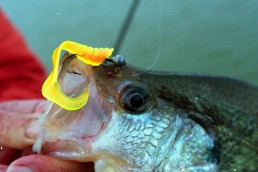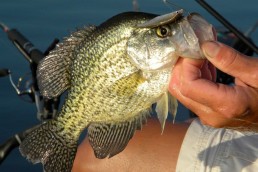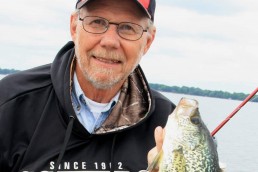Customizing Curly-tail Grubs for more Crappies
SHARE THIS POST
Few things are simpler than a curly-tailed grub for crappie fishing, but a longtime guide on Kentucky Lake has devised imaginative ways to gain even more versatility and productivity out of these simple lures. All you need is a pair of snippers and some understanding of aquatic physics.
“Everyone thinks of color first,” Malcolm Lane says, “but the most important thing is presentation. What I’m doing is changing the action and presentation in ways that trigger more strikes.”
Lane is the oldest guide on Kentucky and Barkley lakes, both renowned crappie producers in western Kentucky. For decades the state has billed itself “The Crappie Capital of the World.” If that’s true, Lane could be considered its mayor. What he’s been doing there will work no matter where panfish are found.
Lane has guided crappie fishermen for 50 years, but that doesn’t mean he’s stopped trying to find better ways to catch more and bigger specks. Now that he’s cut back on guided trips, Malcolm is devoting most of his time to tinkering with baits and following the Crappie USA Tournament Trail as a representative for Mepps and Mr. Twister.
What he’s done to plastic curly-tail grubs lately is simple, yet effective. I’ve been trying to come up with a name for this ingeniousness, and finally have decided to keep that simple, too: “grub snipping.”
Most of the grubs used are small, but Lane has been using 2- and 3-inch grubs. With his snippers, he trims the front one-third off at an angle. This shortens a 3-inch grub to 2 inches long, and a 2-inch grub to about 1 1/4 inches. The larger 3-inch version is best for grub snipping because the body has a larger diameter, thereby having a larger affect upon the hydrodynamic flow across the face. Clipping the grub at an angle one way causes it to glide through the water and to fall slower when you pause the retrieve. Clipping it the other way causes it to fall faster and dive straight down when you pause the retrieve.
The implications of these alterations have an obvious affect upon the depth and presentation of the standard curly-tail grub, but grub snipping does much more than simply affect the rate of decent.
As a grub is retrieved, the water forced across the face causes it to actually wobble slightly from side to side creating a swimming action that closely mimics a live minnow. This wobble is very slight; you’ve got to look closely to notice it. This seems to have a profound effect upon the “brains” of crappies that grow large by reading subtle differences in the body language of their prey.
Are you enjoying this post?
You can be among the first to get the latest info on where to go, what to use and how to use it!
This wobbling action also imparts more action to the tail. To take full advantage of this bonus, Lane prefers Mister Twister Original Curly-Tail Grubs that feature a fairly wide ribbon-like tail.
“It’s important to clip the grub head evenly and to mount it straight on the jig head.”
Most of the time, he uses a 1/16-ounce jig with a ball head and a number 4 hook.
“The action is even greater with a 1/32-ounce head,” Lane adds, “but casting can be a little difficult in the wind so most people are better off using the heaver head.”
This makes a 6-pound-test line is pretty standard.
The amount of glide or dip grub snipping imparts, and the amount of wobble, varies with the angle at which you clip the head. A steeper angle creates a wider wobble, but produces less dive or glide. A longer angle imparts less wobble, but gives steeper dive or a longer glide.
This is a brand new twist on time-honored crappie baits and their presentation. It allows a lot of room for experimentation, which is part of the fun of fishing in the first place.
So grab a pair of snippers and go fishing.
MWO
SHARE THIS POST
Did you enjoy this post?
You can be among the first to get the latest info on where to go, what to use and how to use it!
Ron Kruger
Ron Kruger has been communicating the outdoor experience for more than four decades. He has worked as a full-time guide for trout on the North Fork, for crappies and bass on Kentucky Lake and for smallmouths on the Current River. He has served as editor of three outdoor magazines, and owns a patent on a fly/lure called the Desperate Diver.



